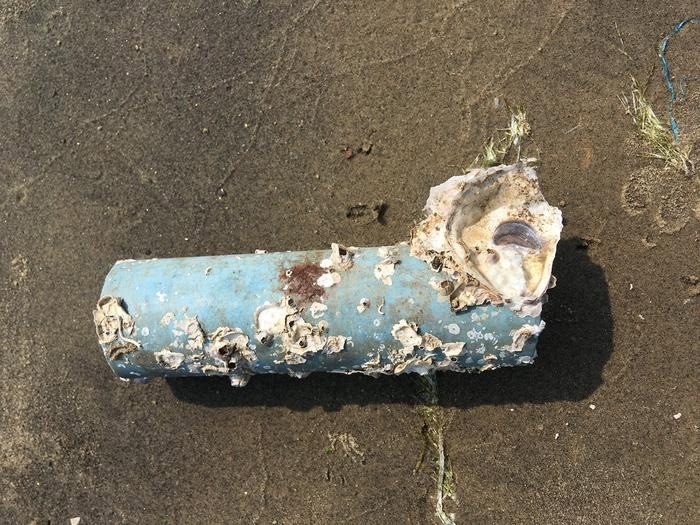An urgent environmental concern has been brought to light by a ground-breaking scientific study carried out along the Southeast coast of India: the growing likelihood of invasive species colonizing marine debris. The study explores the intricate relationship between plastic pollution and the introduction of non-indigenous creatures into Indian waters. It was published in the Marine Pollution Bulletin.
 The accumulation of marine debris occurs especially near highly populated cities or tourist destinations. Image Credit: Dr. Gunasekaran Kannan
The accumulation of marine debris occurs especially near highly populated cities or tourist destinations. Image Credit: Dr. Gunasekaran Kannan
Marine life has been able to colonize a wide variety of substrates, thanks to the increase in anthropogenic waste in the ocean in recent years. This buildup of marine debris has unintentionally become a vector for the spread of fouling species, with far-reaching ecological and economic repercussions, particularly when it comes to densely populated areas or popular tourist sites.
A thorough investigation of fouling organisms on a variety of stranded litter types, such as plastic, glass, rubber, foam sponge, cloth, metal, and wood, was conducted by the research team, which was led by the Institut de Ciències del Mar (ICM-CSIC) and the Sathyabama Institute of Science and Technology in collaboration with the University of Barcelona (UB), the Abdelmalek Essaadi University (UAE), and the University of Oslo (UiO).
A shocking realization emerged from their painstaking work: 3,130 specimens/colonies representing 17 species and seven phyla.
Traveling on Marine Debris
The findings show that Mytella strigata, an invasive mussel, is affixed to fishing nets in high-density groups.
This discovery emphasizes the significant role of marine litter in facilitating the spread of invasive species, potentially disrupting the ecological balance of Indian waters.
Dr. Gunasekaran Kannan, Study First Author and Scientist, Centre for Aquaculture, Sathyabama Institute of Science and Technology
He added, “Litter items with high buoyancy, such as bottles, buoys, and plastic bags supported abundant macroinvertebrate assemblages, suggesting the potential for long-distance transport.”
The ubiquitous bryozoans Jellyella tuberculata and J. eburnea, the barnacles Lepas anserifera, Amphibalanus amphitrite, and Amphibalanus sp., and the oysters Saccostrea cucullata and Magallana bilineata were among the most often observed organisms linked to marine debris.
Combating Plastic Pollution
This study is the first to document the use of marine litter in India as a vector for the spread of species.
The results highlight the increasing risk of invasive species colonization on plastics along the southeast coast of India. This is particularly worrying at a time when plastics are becoming a more and more common substrate for marine organisms, especially in India, which is one of the top countries contributing most to ocean plastic pollution. Our study thus serves as a call to immediate action to address plastic pollution and its related threats in India.
Dr. Blanca Figuerola, Study Last Author and Postdoctoral Fellow, Institute of Marine Sciences
Dr. Anna Sanchez-Vidal, study co-author and associate professor in the UB Department of Earth and Ocean Dynamics, member of the UB's Marine Geosciences Consolidated Research Group, added, “The dominance of plastic in the fouled marine litter is evident, representing 75.5% of the fouled litter items found.”
She further added, “Effective waste prevention and management, education, and awareness campaigns are imperative to mitigate the introduction of invasive species via marine litter. Local and global stakeholders must come together to address this critical issue and protect the fragile marine ecosystems along India’s southeast coast.”
In a recent study, the team had already issued a warning about the role that marine plastic litter was playing in the introduction and movement of non-native marine species along the Catalan coast. In light of this situation, the specialists decided to extend their research into new areas in cooperation with other academic institutions and research facilities, which has enabled them to publish this most recent work.
Dr. Figuerola concluded, “This kind of studies are also effective for early detecting invasive species. However, prioritizing international cooperation to coordinate efforts aimed at reducing the proliferation of floating plastics is essential, ultimately curbing the risk of invasive species transportation between oceans.”
Journal Reference:
Kannan, G., et al. (2023) Increasing risk of invasions by organisms on marine debris in the Southeast coast of India. Marine Pollution Bulletin. doi:10.1016/j.marpolbul.2023.115469